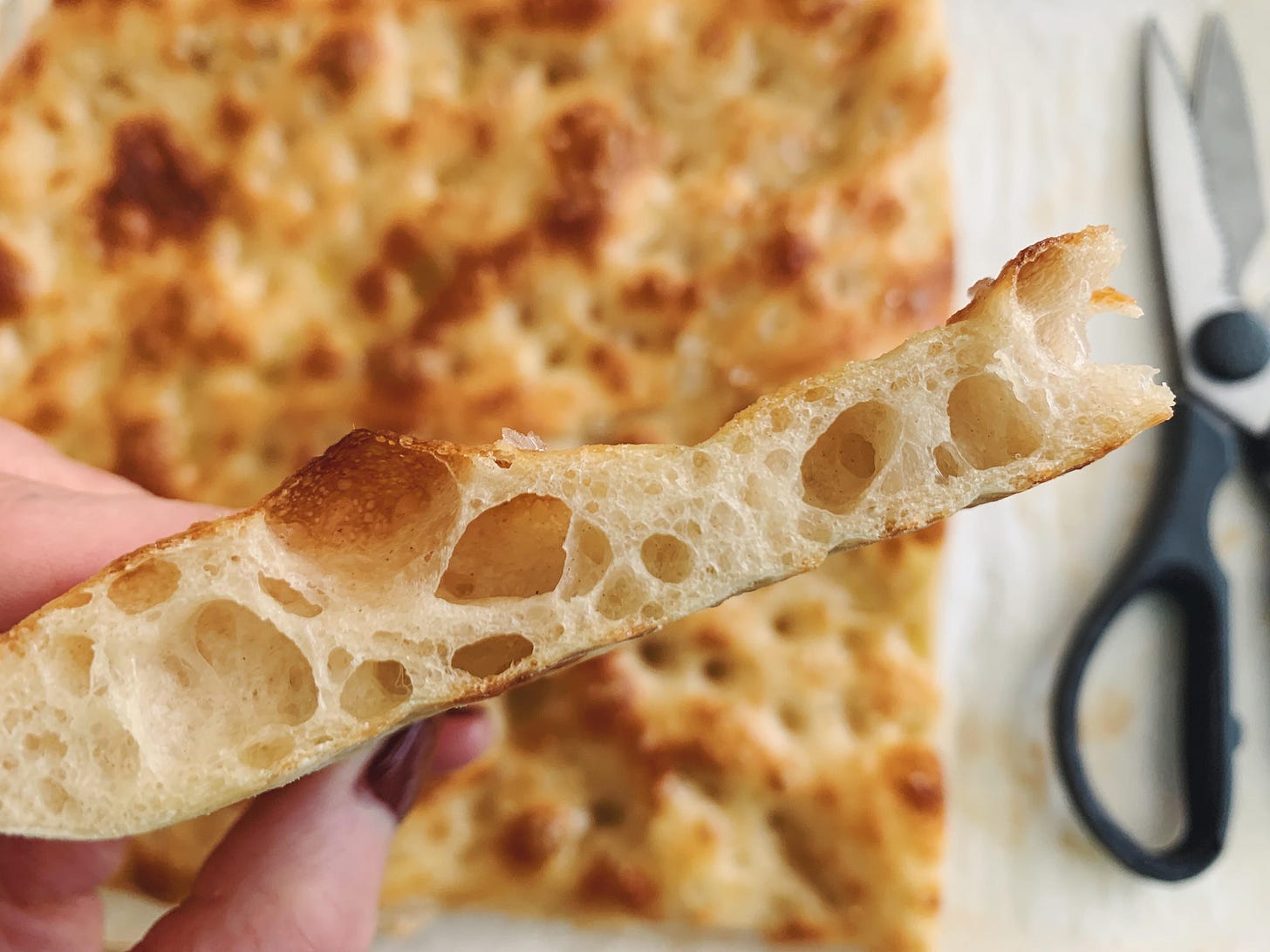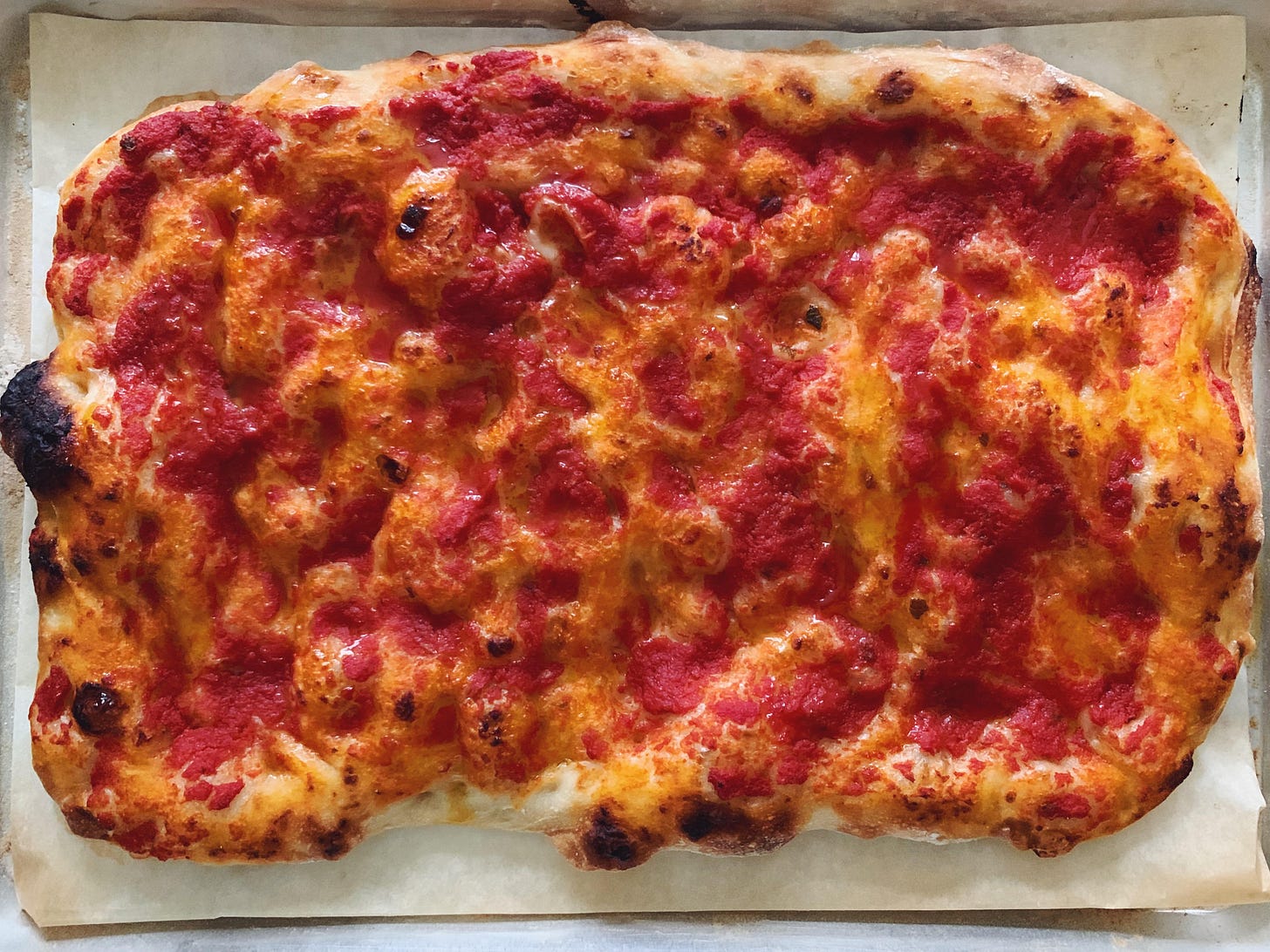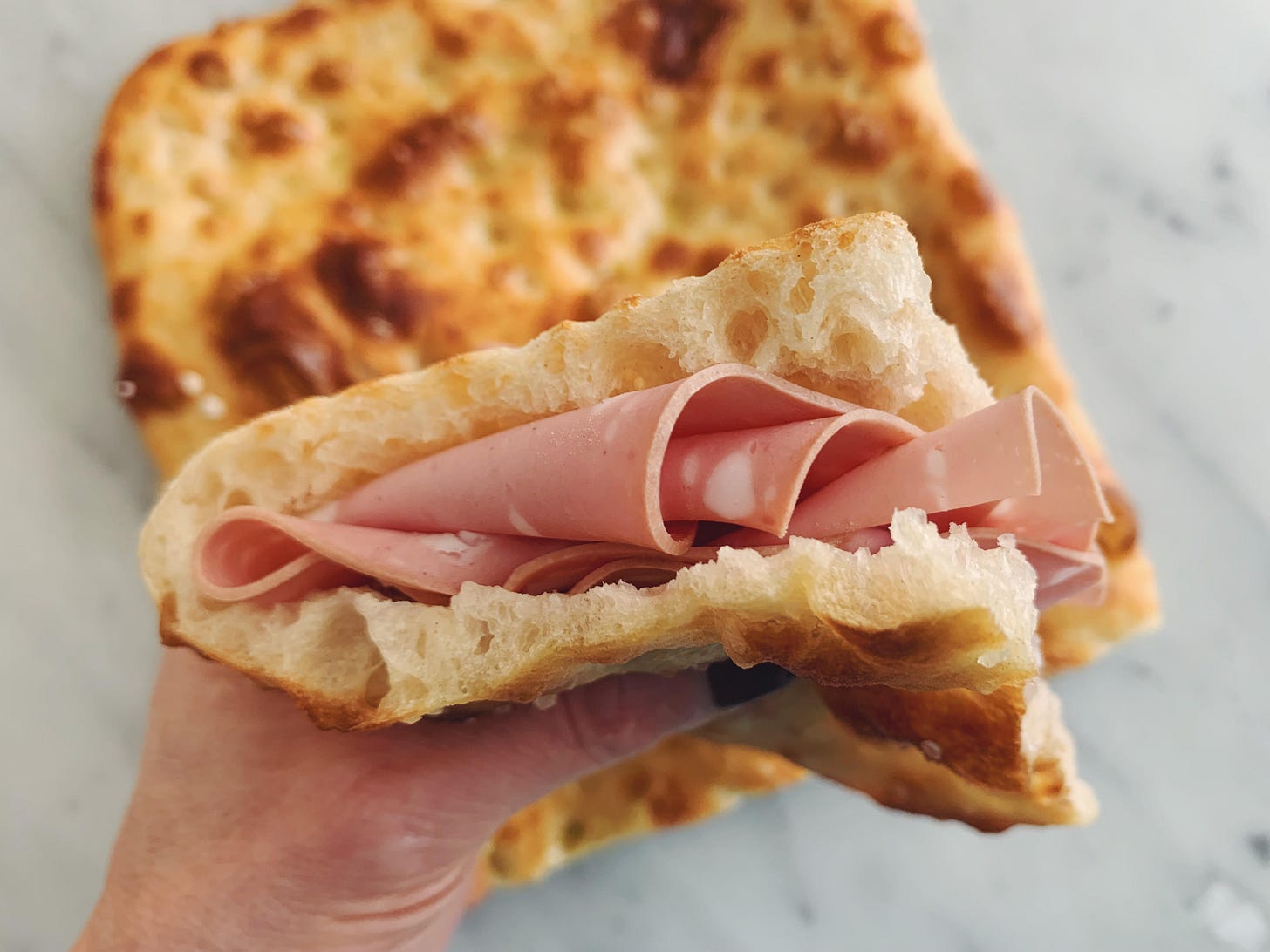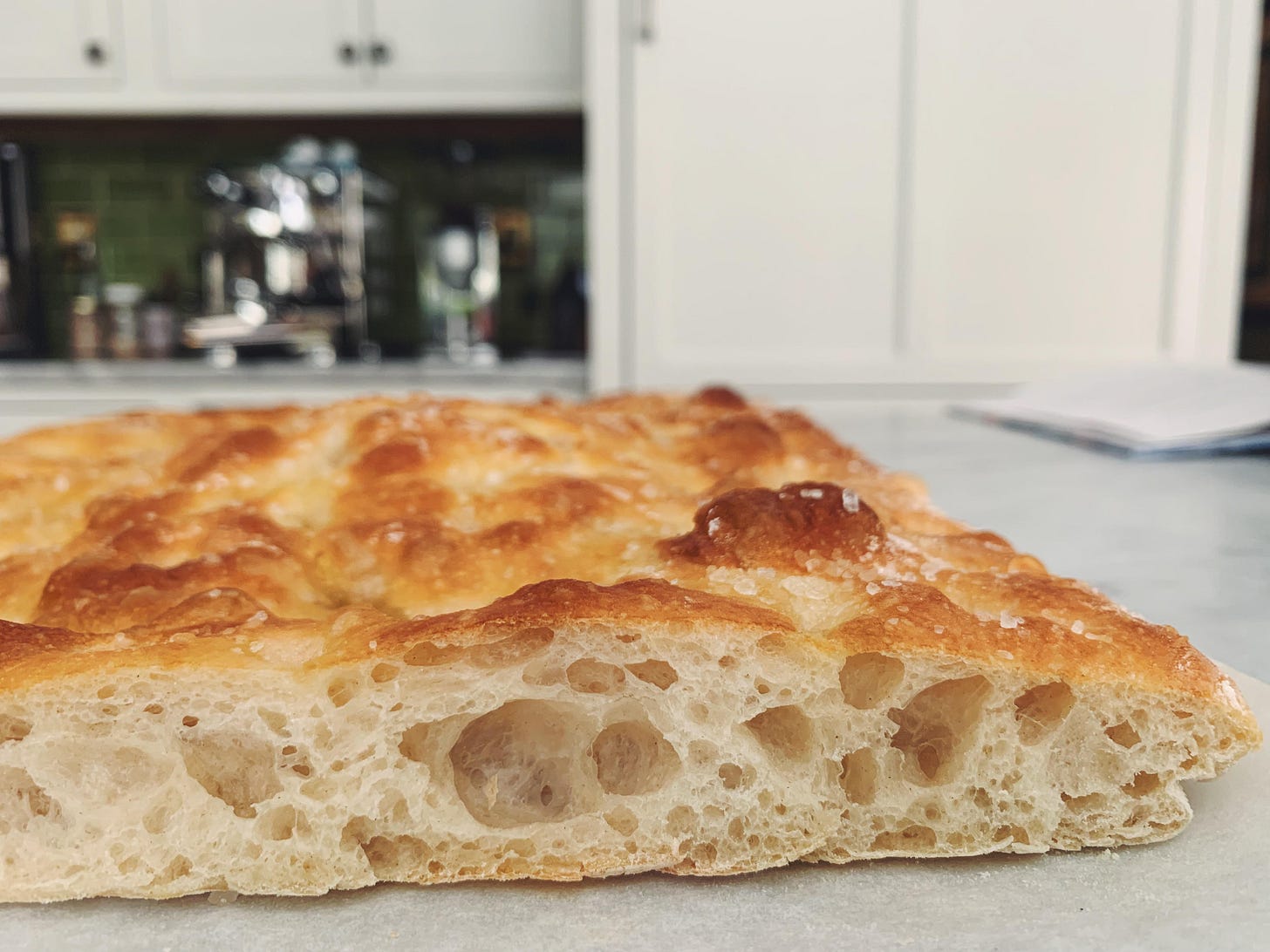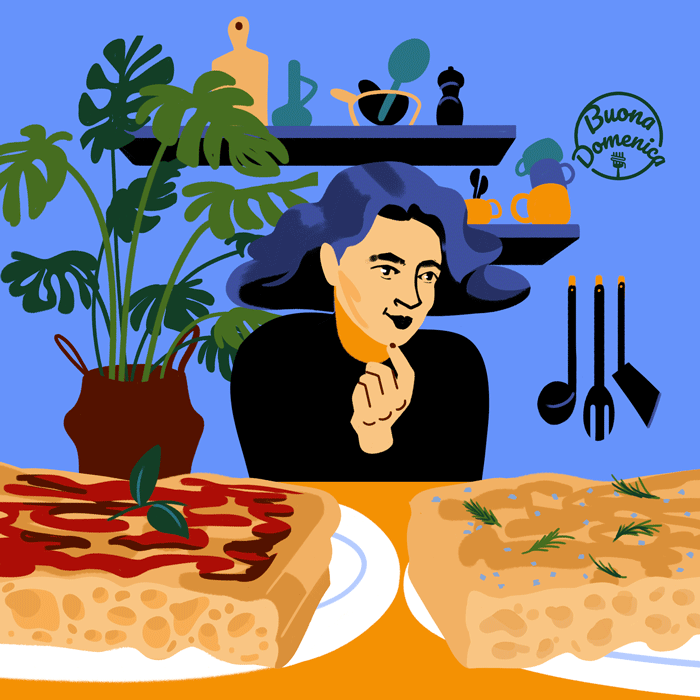
Welcome to Buona Domenica, a weekly newsletter of inspired Italian home cooking and baking. I’m a journalist, cooking instructor, occasional tour guide, and author of eight cookbooks on Italian cuisine. Click here to browse through the newsletter archive. If you’re looking for a particular recipe, you’ll find all Buona Domenica recipes—143 and counting—indexed here, ready to download or print—a function for paid subscribers.
This week’s newsletter features an extensively tested recipe for Pizza Bianca, plus a variation for Pizza Rossa. Perfecting these recipes took weeks of testing, tweaking, and photographing process shots, so they are behind the paywall. If you would like access to all recipes and archived newsletters, please consider becoming a paid subscriber. Grazie.
There was a rosticceria near my aunts’ apartment in Rome where we would sometimes pick up lunch. The place was small, situated right at the “V” where two residential streets intersected. Inside, an open rotisserie behind the counter was strung with rows of juicy chickens turning slowly on their spits. The display case, which ran the length of the shop, was filled with classic rosticceria accompaniments: patatine (French fries) and fried zucchini, supplì di riso and potato croquettes, trays of pasta al forno, and a selection of thin, minimally adorned pizzas: pizza bianca, pizza rossa, onion pizza, and potato pizza. There was always a crush of customers in the shop, jostling for position at the counter. Elsa, my mom’s older sister, would walk in and wade through them to stake out a place at the front of the counter. She was tiny—maybe 5-foot-2 and probably less than 100 lbs—but formidable, with a prominent nose, jet black hair, and a wiry frame. She carried a high opinion of herself (deservedly so; she was a respected teacher at one of Rome’s licei classici), and rightly or not, she often got away with such roguery.
While wandering through the area with my husband a couple of years ago, we came upon that same corner. The rosticceria was no longer; it had been transformed into a modern eatery or juice bar, I can’t remember exactly, something with a washed blonde wood interior. I was filled with a longing for the old place, with its patina of grease, whose perfume of fried potatoes, chicken drippings, and freshly baked pizza I could still smell as though I had just stepped out of it.
A few months ago, while reading
’s book Portico: Cooking and Feasting in Rome’s Jewish Kitchen, my eye fell upon her recipe for simple pizza bianca. I wrote about Portico back in December. It’s one of my favorite cookbooks from 2023. The recipes are timeless; many of them, including the pizza bianca, take me right back to the 1970s and 80s and the days I would spend in Rome with my mom and sister and aunts at the beginning and end of our summer vacations in Italy.Leah’s recipe became the template for the recipe I’m sharing here. I’ve made some changes in ingredients and method, using a mix of flours to get the desired amount of “chew” in the crust; mixing the ingredients by hand; and reducing the amount of yeast significantly so I could give the dough a slow, cold rise in the fridge. (If you’re looking for a quick recipe to mix and bake in a matter of a few hours, check out Leah’s recipe in Portico.)
Pizza bianca is similar to focaccia, but they are not the same. Focaccia is made from oil-enriched dough and it tends to be tender and fluffy, whether it is thin Ligurian-style focaccia, thick potato focaccia from Puglia, or the tall, bubbly sourdough focaccia that became so popular among home bakers during lockdown. Pizza bianca is thin, with crunchy edges, a crispy top and a chewy crumb. There is no oil in the dough, though olive oil is lightly brushed on top of the dough right before it’s baked and then, once more, when it comes out of the oven.
Pizza rossa is pizza bianca dressed with a thin layer of lightly seasoned tomato purée—no cheese. When I posted the above photo on my Instagram feed a few days ago, one person commented, “I used to think pizza rossa was missing something, but then I took my first bite and realized it was everything.” She is exactly right. For the last couple of months, as I’ve been working on these recipes, I’ve been baking pizza bianca and pizza rossa a couple of times a week. They remind me so much of the pizza bianca and pizza rossa from that old rosticceria; when one is in the oven, it perfumes the kitchen with the aroma of toasting flour and baking dough. It fills me with nostalgia, it makes me want to go back in time, it makes me happy. I’m pretty sure it will make you happy, too.
Are you a pizza lover like me? Check out , a tasty pizza-centric newsletter by .
What’s your favorite style pizza?
TIPS FOR MAKING PIZZA BIANCA
Use a scale to weigh your ingredients. This is especially important for weighing the flour, as the amount that ends up in a measuring cup can vary dramatically depending on how you fill the cup.
This is a wet, sticky dough. Normally, I would just coat it, and my hands, with oil when shaping it, but because the pizza bianca is not oil-rich, I use flour to help mitigate the stickiness. I flour my hands, and I flour the parchment that I use to line the baking sheet so the dough doesn’t stick to it. Don’t let this issue worry you too much, though. Follow the instructions in the recipe and you’ll see that the more you work with this dough, the easier it gets.
Use a pizza stone or baking steel. If you have one of these tools, use it to give your pizza a crispy bottom. Although you can bake the pizza directly on the stone or steel, I prefer to bake it in a parchment-lined rimmed baking sheet that I set on my baking stone. This is easier than trying to successfully place the soft, sticky dough neatly onto the super-hot surface of the stone; plus, it doesn’t get flour all over the oven, and it still yields a crispy, lightly browned bottom crust.
Bake one pizza or two. You can use the entire batch of dough to form one large pizza that fits on an 11-by-17-inch (28-by-43-cm) rimmed baking sheet. But I like to divide the dough in half and bake two medium-sized pizzas (I use a 10-by 14 1/2-inch / 25-by-37-cm rimmed baking sheet). This allows me to stretch the dough more to get a properly thin pizza bianca with a crispy-chewy texture. Also, I can top one pizza with tomato and have both pizza bianca and pizza rossa. Or, if I just want one pizza, I leave the half the dough in the fridge to bake a fresh pizza the next day, or I freeze it to use later. (See the RECIPE NOTES at the end of the recipe for how to freeze pizza bianca dough.)
The best part of all. Although pizza bianca is thin, it’s not so thin that you can’t slice it open and fill it with silky slices of mortadella to make the most delicious sandwich of all: pizza e mortazza (pictured above).
RECIPE: Roman-Style Pizza Bianca
Like most pizza and focaccia, pizza bianca is best freshly baked, or at least within a few hours of baking. If you do have leftovers, store them in a tightly lidded plastic container or a zipper-lock bag. Reheat the pizza on a baking sheet a moderately-low oven until warmed through.
Keep reading with a 7-day free trial
Subscribe to Buona Domenica to keep reading this post and get 7 days of free access to the full post archives.





